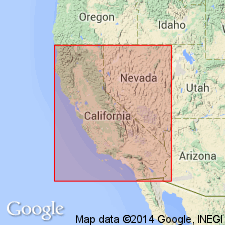
- Usage in publication:
-
- Wallala beds
- Modifications:
-
- Original reference
- Dominant lithology:
-
- Sandstone
- Conglomerate
- AAPG geologic province:
-
- California Coast Ranges province
Summary:
Pg. 7-17. Wallala beds. A series of sandstones and conglomerates extending along the coast from near Fort Ross at least to Wallala, Mendocino County, northwestern California. In some places they rest unconformably on metamorphosed rocks thought to belong to Knoxville group. Fauna not decisive as to age. Fossils collected near Wallala are regarded by C.A. White as probably pre-Chico and younger than Knoxville. [Age is Late Cretaceous.]
[GNC remark (ca. 1936, US geologic names lexicon, USGS Bull. 896, p. 2267): the beds referred to belong to lower part of Chico formation.]
Source: US geologic names lexicon (USGS Bull. 896, p. 2267).
- Usage in publication:
-
- Wallala group
- Modifications:
-
- Revised
- AAPG geologic province:
-
- California Coast Ranges province
White, I.C., 1885, On new Cretaceous fossils from California: U.S. Geological Survey Bulletin, 22, 25 p.
Summary:
Pg. 8. Wallala group. Since so little is known of stratigraphic relations of Wallala and San Diego beds with other formations. I cannot now discuss them fully, but I shale give them the provisional name Wallala group, referring those of both localities to one and same formation. [Age is Late Cretaceous.]
[GNC remark (ca. 1936, US geologic names lexicon, USGS Bull. 896, p. 2267): the beds referred to belong to lower part of Chico formation.]
Source: US geologic names lexicon (USGS Bull. 896, p. 2267).
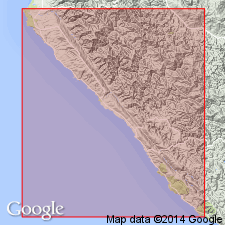
- Usage in publication:
-
- Gualala series
- Modifications:
-
- Named
- Dominant lithology:
-
- Sandstone
- Conglomerate
- Shale
- AAPG geologic province:
-
- California Coast Ranges province
Summary:
Named for town of Gualala at mouth of Gualala River, Mendocino Co, CA. [Formerly known as Wallala group of White (1885)] Occurs in Point Arena-Fort Ross region in Mendocino and Sonoma Co. Type section not designated. Consists predominantly of massive and stratified brownish-gray medium- to coarse-grained quartzose sandstone; conglomerate lenses common near base and middle of series; also thick layers of clay shales; interstratified shaly sandstones and sandy shales constitute 30 percent of unit. Thickness is approximately 20,000 ft. Beds lie in two major synclinal and two anticlinal folds whose axes trend diagonally to course of San Andreas fault. Age is Late Cretaceous.
Source: GNU records (USGS DDS-6; Menlo GNULEX).
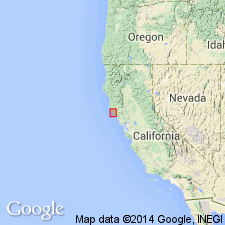
- Usage in publication:
-
- Gualala series
- Modifications:
-
- Age modified
- AAPG geologic province:
-
- California Coast Ranges province
Summary:
Stratigraphic table shows Gualala series as underlying Skooner Gulch basalt (new) and overlying Franciscan group (Franciscan absent west of San Andreas fault). Is 21,650 feet thick. Age is Cretaceous.
Source: GNU records (USGS DDS-6; Menlo GNULEX).
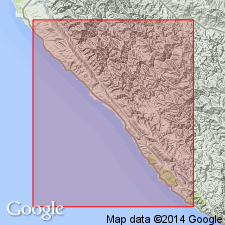
- Usage in publication:
-
- Gualala group
- Modifications:
-
- Revised
- Age modified
- AAPG geologic province:
-
- California Coast Ranges province
Summary:
Gualala [Wallala] series of White (1885) renamed Gualala group [!]. Consists of alternating lithologic units of massive and stratified grayish-brown medium- and coarse-grained sandstone, gray and brown clayey and sandy shales and layers or lenses of fine and coarse conglomerate. Measured sections near Horseshoe Point, Black Point anticline, and Ferguson anticline are included. Fossil localities and species list are included. Overlies diabase of possible Franciscan age at Bihler's Point. Unconformably underlies Iversen basalt (new). Age of group is Maestrichtian (F.M. Anderson) based on fossil collection in gulch near sea cliffs one mi north of Gualala.
Source: GNU records (USGS DDS-6; Menlo GNULEX).
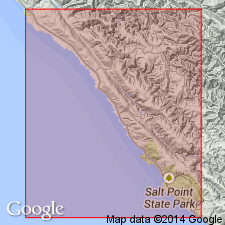
- Usage in publication:
-
- Gualala "group"
- Modifications:
-
- Age modified
- AAPG geologic province:
-
- California Coast Ranges province
Summary:
"Some poorly preserved fossils from the Gualala 'Group' near Stillwater Cove suggest the possibility of an early Eocene or Paleocene age for part of the sequence."
Source: GNU records (USGS DDS-6; Menlo GNULEX).
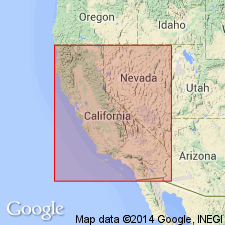
- Usage in publication:
-
- Gualala Formation
- Modifications:
-
- Revised
- AAPG geologic province:
-
- California Coast Ranges province
Summary:
Because of its "Cretaceous connotation" Gualala ["Gualala group" of Weaver (1944)] is herein restricted to mappable stratigraphic unit of Late Cretaceous age, named Gualala Formation. Two synchronous members are distinguished (ascending): Stewarts Point and Anchor Bay Members (both new).
Source: GNU records (USGS DDS-6; Menlo GNULEX).
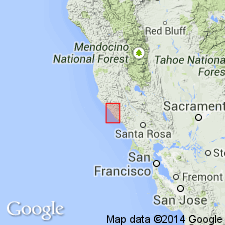
- Usage in publication:
-
- Gualala beds*
- Modifications:
-
- Overview
- AAPG geologic province:
-
- California Coast Ranges province
Summary:
Lithologic and isotopic dating of clasts of mafic conglomerate and quartz-plagioclase arkose of Late Cretaceous age near Gualala, CA may indicate Gualala beds [Gualala Formation] may have eroded from terrane currently located 350 mi to the southeast, on the opposite side of the San Andreas fault.
Source: GNU records (USGS DDS-6; Menlo GNULEX).
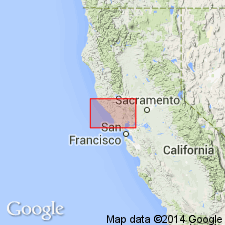
- Usage in publication:
-
- Gualala Formation
- Modifications:
-
- Mapped
- AAPG geologic province:
-
- California Coast Ranges province
Summary:
Mapped in Santa Rosa 7.5' quad, Sonoma Co., CA. Described as marine deposits of sandstone, mudstone, and conglomerate of Stewart's Point and Anchor Bay. Is in fault contact with Franciscan Complex. Underlies German Rancho Formation and unconformably underlies Pleistocene terrace deposits. Age is Cretaceous.
Source: GNU records (USGS DDS-6; Menlo GNULEX).
- Usage in publication:
-
- Gualala Formation*
- Modifications:
-
- Geochronologic dating
- AAPG geologic province:
-
- California Coast Ranges province
Schott, R.C., Johnson, C.M., and O'Neil, J.R., 2004, Late Cretaceous tectonic history of the Sierra-Salinia-Mojave arc as recorded in conglomerates of the Upper Cretaceous and Paleocene Gualala Formation, northern California: Journal of Geophysical Research, B, Solid Earth, v. 109, no. 2, B02204, 22 p.
Summary:
Gualala Formation. Sources of conglomerate clasts from Stewarts Point and Anchor Bay Members of the Gualala Formation (as originally delineated by Wentworth, 1966) are broadly subdivided into two types, continental and oceanic suites, on basis of age and composition. Clasts of continental origin are most commonly rhyolitic or granitic (often porphyritic) and have Cretaceous crystallization ages, whole-rock U-Pb ages (on zircon) from 125 +/-4 Ma to 85 +/-5 Ma; their chemical and isotopic compositions suggest an origin on the eastern (continental) side of the Cretaceous magmatic arc of California (e.g., Salinian block or eastern Sierra Nevada batholith). In contrast, clasts of oceanic origin have gabbroic to quartz diorite compositions, Late Jurassic crystallization ages, whole-rock U-Pb ages (on zircon) from 158.5 +/-0.5 Ma to 144 +/-2 Ma, and chemical and isotopic compositions characteristic of an oceanic source. Contemporaneous deposition of the contrasting lithologies is interpreted to reflect tectonic juxtaposition of the source terranes. Chemical, isotopic, and age data tie the Gualala basin to North American continental basement in the Mojave-Salinian segment of the Mesozoic Cordilleran arc and, contrary to some previous studies, imply minimal pre-Neogene movement of the basin.
Source: Publication.
For more information, please contact Nancy Stamm, Geologic Names Committee Secretary.
Asterisk (*) indicates published by U.S. Geological Survey authors.
"No current usage" (†) implies that a name has been abandoned or has fallen into disuse. Former usage and, if known, replacement name given in parentheses ( ).
Slash (/) indicates name conflicts with nomenclatural guidelines (CSN, 1933; ACSN, 1961, 1970; NACSN, 1983, 2005, 2021). May be explained within brackets ([ ]).

